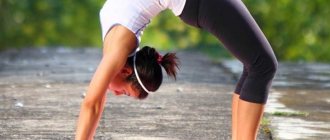Stair running is an alternative training option if for some reason it is not possible to run outside or in an arena. What qualities does this type of running develop, what are its advantages and how to run up the stairs correctly so as not to harm yourself, read in this article.
Do you want to train in the cold season with the same pleasure and dedication as in the summer? – Is this possible, or are amateur runners, every year with the onset of the cold and snowy season, doomed to sadly reduce their running volumes, deny themselves speed work if there is no accessible athletics arena at hand, and wait for spring?
Among the usual recommendations on how to survive the off-season, the most common one is to focus on general physical fitness and strength training. But this doesn’t always work: some people immediately reject the idea of regularly going to the gym, some try it and as soon as they get bored, they give up training - still, to be honest, most of us, amateur runners, are not very -what he likes to do – in a group and as a team, under the supervision of a coach, no matter what. What can we say about at least partially replacing running with general physical training.
You can look for different alternatives: from cross-training to completely changing sneakers to skis for the winter. But what if you still want to keep running? And so that it is varied: both intensive and developing, and without the fear of getting sick? Here it’s time to remember Rocky Balboa, from whom, in addition to discipline and obsession with the training process, you can definitely borrow stair running as a type of training.
On the subject: How to replace running: 13 alternative options
What does running up stairs do?
The positive effects of stair running as a plyometric, strength and aerobic exercise are clear. Like plyometrics, running on stairs strengthens the same muscle groups as lunges and squats, pumping our ligaments and tendons, preventing injury.
In the form of a strength complex, it gives the runner not only speed and power, but also technicality and economy of running, activates stabilizer muscles and often those muscles that should take part in the running process, but for some reason do not work. It also has a pronounced effect on the functioning of our cardiorespiratory system and makes us more resilient.
Training plans for marathon and half marathon. and start preparing today.
Here the steps can be compared to running up a good hill, because the slope of the steps indoors is usually much greater than any of the hills or rises that you will find in the area, so running up the stairs will also help in preparing for trails.
In addition, in the off-season, one should not miss the fact that running up stairs allows you to burn calories very well, so if you want to stay dry and fit, monitor your weight during the winter season, then this may be another reason to include running in your workout. stepping stones into your workouts.
What are the benefits of walking up the stairs?
The staircase is a simulator that is accessible to everyone; you don’t have to pay to use it, it’s always under your feet and all you need to do is desire. As a result of methodical training, it is possible to:
- Effectively lose excess weight without exhausting diets, since climbing stairs and subsequent descent burns more calories than, for example, running;
- Strengthen the cardiovascular system, literally avoid stroke and heart attack;
- Improve health and increase life expectancy;
- Increase the vital capacity of the lungs and cope with diseases of the respiratory system;
- Correct your figure, including problem areas (buttocks, thighs);
- Strengthen the muscular frame of the back and abdomen.
Benefits of Stair Running
Running on stairs has now been well studied in the scientific literature, and if you want to find out more facts confirming the benefits of steps in the training process, it will not be difficult. Here are just a few of them.
A study published in BMJ Open Diabetes Research & Care shows that vigorous walking up and down stairs for 3 minutes, some time after eating, leads to lower blood sugar levels in subjects with type 2 diabetes.
The British Journal of Sports Medicine reports that even small additions of stair running 5 times a week for 8 weeks lead to a 17% increase in VO2 max.
And running on steps for 10 minutes 3 times a week after 6 weeks gives a significant increase in general functional indicators - heart rate, recovery time, breathing rate, exercise tolerance - according to the journal Medicine & Science in Sports & Exercise.
There are even studies that show that 10 minutes of stair training can invigorate and give you more energy and strength than a mug of coffee. Researchers from Georgia University found that the effects of the steps were greater than those of 50 mg of caffeine.
And if you suddenly get carried away by the process of running up the stairs, then there is an international association of fans of running into skyscrapers - Towerrunning World Association. Their website presents an entire world tour of the planet's largest skyscrapers, from the Empire State Building (a climb to the 86th floor with 1,576 steps) to the skyscrapers of China, Mexico, Great Britain, the Netherlands, Estonia and Croatia. Participants have ratings, qualifying and final races - in general, excellent competitive motivation.
And in Russia now they already have their own high-altitude races, you can practice at home.
How to organize training
There are no uniform rules for walking up stairs. Each person must select the load individually, taking into account age, health status and the goal being pursued.
There are two main postulates that must be adhered to, guided, in the future, by the results achieved.
- Start small: the duration of the first workouts does not exceed 5 minutes, this means climbing the stairs to a height of 2-3 floors and descending. Gradually the load increases, reaching 20 minutes or more.
- Running or walking – the one who exercises chooses. Training should not cause discomfort. Shortness of breath indicates that the pace taken initially was too high. It is necessary to moderate the rhythm and reduce the load to a comfortable level. It is very important to monitor your breathing.
Recommendations
In short, the reasons are very compelling to consider incorporating this type of training into your routine. But where to start preparing? And how can you include running up stairs in your training process as gently and correctly as possible? Although running up the stairs seems easy, it has its pitfalls, so at the initial stage it is better to follow the general recommendations:
1. Be sure to do a good warm-up before you start running up the stairs. This can be a light jog outside to warm up and then a joint warm-up, consisting of basic exercises: rotations, bends, swings, outlines, lifts on the foot and rolls - in place and in motion. Spend 10 minutes on this, and always start the first steps of the stairs by walking, not running, so you will prepare the body to more gently accept the load.
2. During training, monitor the position of your head and body, stay straight, look in front of you, and not down at your feet.
3. Add load gradually, start with walking and running/walking switches, and only then move on to running to the 14-20th floor.
4. Keep the duration of training on the stairs no more than 20-30 minutes.
5. Include stair running as separate workouts in your plan once a week or add small blocks to an existing training plan depending on the nature of the activity: in the form of a strength complex, developmental exercises or high-intensity interval running.
6. Don't forget about foot recovery. 30-minute workouts on concrete staircases can be quite a significant load. Therefore, after such exercises, it will be useful to do exercises for your toes, roll your feet with a ball and do a light massage.
Running up the stairs. Training plan
What might your stair workout look like? Let's look at a few examples.
Day 1
Type: ORU (developmental exercises)
Training. After a 10-minute warm-up, we choose 1 flight of stairs, 10 steps, perform the exercise up, and go down easily by running.
We practice the following exercises:
- easy calm running – “1 leg 1 step”;
- fast technical running – “1 leg 1 step”;
- “running through 1 step” - repeat 2 times;
- “climbing” (someone may need to hold onto railings or walls) through 2 steps - repeat 2 times;
- “running with one side” / “running with the other side”;
- easy calm running – “1 leg 1 step”.
If you wish and have time (and good condition of your legs), this short complex can be done in 3-4-5 approaches, several times a week. In terms of time, it will take you on average from 1.5 to 5-6 minutes.
Day 2
Type: walking/running
Training. After a 10-minute warm-up, we work in the following format: 1 flight of stairs (10 steps) walking, the next flight (10 steps) – intense running. To begin with, you can use the average number of floors of a house of 10-14 floors: up in walking/running mode for 2-3 minutes, 4-5 minutes - lightly jogging down. Do 4-5 approaches.
In the future, increase the number of approaches, bringing the total duration of the workout to 30 minutes. You can also vary not only the number of approaches, but also the duration of the runs. Once you have mastered running 1 flight, you can try switching “running 2 flights/walking 2 flights”, “running 3 flights/walking 3 flights” and, if necessary, add intensity: “running 2 flights/walking 1 flight, running 3 flights” /walk 1 flight.”
Day 3
Type: running + strength training
Training. After a 10-minute warm-up, we choose 2-4 flights of stairs, which you will run up for a while, and at the top do one of the strength exercises of your choice: push-ups, squats, jumping out of the bottom squat, and lightly jog down. A 30-minute workout is best divided into several sets, each of which will consist of 3-4 repetitions, and between them 1-2 minutes of pure rest.
Day 4
Type: Plyometric and Strength Exercises
Training. After a 10-minute warm-up, you can use the stairs as a gym for your actual strength training.
What can you do from general physical training on the steps? Below is a list of exercises that should be performed on the spot before a flight of stairs for 10 to 20 repetitions.
- Stepping onto the step, bringing the leg up to the high hip.
- Step onto the steps, lift your leg into a high hip position, and when returning to the starting position, lunge back.
- Jumping on the steps with your feet one at a time, spread out your feet.
- Jumping onto the steps with both feet from a standing position, and on one foot from a standing position.
- Standing on your hands from the steps, do the “climber” exercise.
- Also, while standing up from the steps, do regular and reverse push-ups.
- Lunge through a few steps. Statics (stand in a lunge and freeze for 20 seconds).
In dynamics, as plyometrics, you can perform the “Skater” exercise on the stairs, as well as jumping on both legs and one leg directly/sideways into the steps.
Day 5
Type: running
Training. After a 10-minute warm-up, you run up to the top floor at a steady, comfortable pace. It is better to start with high-rise buildings no more than 10-14 floors. You time your run up, run away with a light jog, or go downstairs with active walking (also time your time). Based on the time spent, gradually increase the length of the workout, bringing it to 30 minutes.
Don’t forget about recovery after running up the stairs and that after an intense workout, it’s better to do the next session in the recovery format: run actively up the stairs, then run at a slow and calm easy run. With the right planning, stair running can be a great way to vary your winter workouts and make you stronger, faster and more resilient.
SET 3
Diagonal lunges
Stand straight on the bottom step of the stairs with your feet shoulder-width apart. Take a long step forward with your left foot, placing your foot on the third step and lowering into a squat. Push your right heel off the floor and place your right foot towards your left. Immediately step back with your left foot, moving it diagonally behind your right leg and lowering into a curtsey. This will amount to 1 repetition. Perform 10 reps, then switch sides and repeat.
Deadlift jumps
Stand straight, place your feet shoulder-width apart. Lift your left leg and keep it suspended, jump with your right foot onto the first step. Lean forward from the hip while bringing your left leg straight behind you to hip height and try to reach the second rung of the ladder with your left hand. Stand up and jump with your right foot onto the next step. This will amount to 1 repetition. Perform 5 reps, then switch sides and repeat. After completing the jumps, stand on the stairs with your right side and begin to quickly move up, raising your knees high. Quickly go down and repeat on the other side.










